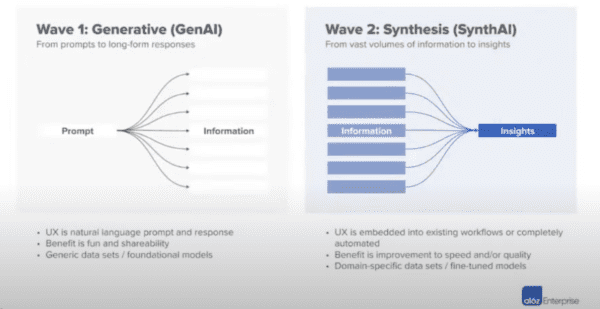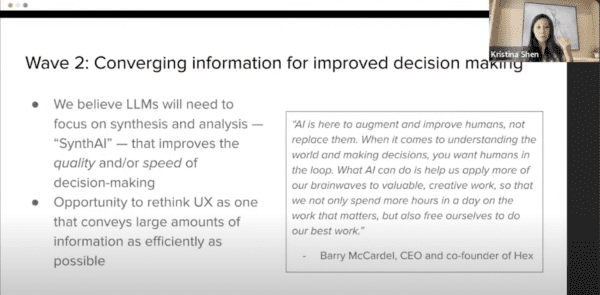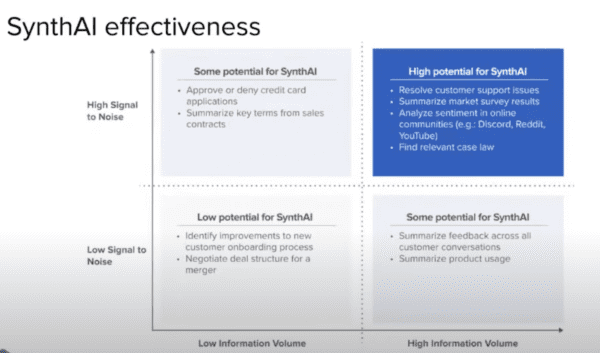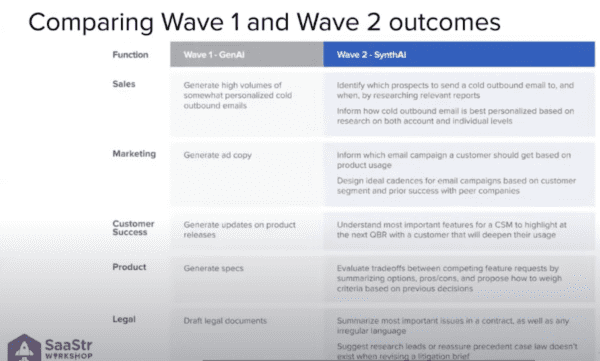How is AI going to impact the software and SaaS landscape of the next couple of years and also the next 5-10 years?
Kristina Shen, General Partner at a16z, shares some insights into the present and future of generative AI at this week’s Workshop Wednesday, held every Wednesday at 10 a.m. PST.
The Most Surprising Thing About VC This Year
Shen has been in venture capital for 12 years now, and it’s been a crazy ride to watch the whole bull market back in ‘10 and ‘11 when 10x revenue was insanely expensive for a SaaS company.
She watched the SaaS and Cloud wave ride and thought there’d be a huge pullback in markets this year.
Of course, it’s down from 2021, but there has been a tremendous amount of innovation in the last year, with a lot of that driven by AI and what’s possible.
More and more kids are dropping out of school because they don’t want to miss out on what’s possible with LMs.
There’s never been a better time to build a company.
With a platform shift with AI and a lot of capital and innovation in the market, who knows what’s to come?
For B2B Generative AI Apps, Is Less More?
In the B2B world, the biggest question is, what will the next couple of years look like? Is less more?
We talk about Generative AI, but what does that mean?
Thanks to OpenAI and a bunch of foundation models where you can start with a text prompt and generate a lot of information, we have incredible power.
You take a prompt, typically text right now, and generate info.
- That info could be:
- high volumes of text like blogs
- contracts
- how to respond to a customer
- images
- video
We’re in the early innings of what it means to generate or have GenAI.
Synthesizing Enormous Amounts Of Information Into Insights
What we don’t talk about a ton is how to take an enormous amount of information and synthesize it down into insights — which the B2B SaaS world cares most about.
It’s how decision-makers make informed decisions.
First, let’s talk about the difference between the consumer and Enterprise world.

Wave 1: GenAI — Crossing The Bridge From Consumer To Enterprise
We’ve seen tremendous amounts of innovation on the consumer side with super fun, creative images or videos (e.g., sending a meme in Discord).
A large percentage of traffic for Generative AI is more salacious.
When the internet first came about, a lot of traffic was more salacious then, too, so it’s nothing new.
On the consumer side, it’s about having fun and doing and creating something new.
On the B2B side, we have different objectives.
- We care about:
- Speed
- Cost
- Quality
If you’re talking to customers, you want any communications to be highly accurate.
Wave 2: SynthAI — Converging Information For Improved Decision-Making
The more judgment and domain expertise required, the more human refinement is also needed. This is where a co-pilot approach is beneficial — having a human involved in the process.
As we think about how AI impacts the B2B world, we think about GenAI pushing out the frontier of quality. We expect even better results in a new generation of AI apps.

The Cost-Benefit Analysis Of Disrupting Workflow
It’s a big debate right now about whether the next wave of AI companies will be:
- Workflow software companies that embed AI intelligence smartly
- AI native first companies that can get us 90% of the answer and embed some of the workflow.
The answer to that will differ by market, but what we do know is…
We’re better off having humans in the loop today.
In the near term, we believe that for a vast majority of white-collar jobs, the role of AI is to augment and improve humans.
It enables data scientists and analysts to do an incredible analysis by leveraging AI, but it still requires a human to make those decisions.

SynthAI and Its Effectiveness
How we think about SynthAI and its effectiveness is by looking for a high signal-to-noise ratio and a high volume of info.
The easiest example is always customer support.
Categories like this will make incredible apps for LMs and AI because of the high volume of tickets and high signal-to-noise.
Where will value accrue in a company?
Existing ticketing systems like Zendesk or Intercom embed AI smartly and capture value.
So, we’re back to the debate. Will it be existing companies embedding AI smartly or new startups who can meaningfully adopt AI faster?
Only time will tell.
SynthAI won’t be as effective for other categories that involve negotiating a complex merger and term sheet.
It’s difficult for AI and LMs to do the last 5-10-20% of human decision-making, which is why the co-pilot approach is necessary.

Comparing Wave 1 (GenAI) and Wave 2 (SynthAI)
Marketing has probably been the category with the most GenAI in the last 12 months. Companies like Jasper have grown tremendously fast around generating copywriting from a text prompt.
It shows the power of how great Generative AI is on drafting in the creative phase.
The next wave in marketing is exciting, which will be personalizing that content for individual customers based on a high volume of information.
How much information can you gather and now dissect and then make informed, insightful decisions that empower action?
SynthAI is deriving insights and empowering an action that is, ultimately, the power of AI — to automate a big component of this and transition from co-pilot to an agent phase.
The Battle To Own The Workflow
Incumbents have been quick to react to the ongoing AI trend.
The battle is between:
- Modern incumbents who embed AI and become even more successful
- The next up-and-coming startup
Is this the age where software companies built in the last 5, 10, or 12 years will exert dominance even more?
Being modern is imperative. It’s important to embed the most recent LMs and build out your own modern AI stack.
Modern incumbents have done well. NotionAI is the fastest-growing AI business, and it’s already an existing product.
Zoominfo recently integrated GPT, and the amount of sales enrichment data helps power lead scoring, outreach to customers, etc.
All of these apps have a huge advantage.
But the early-stage founder also has an advantage, and they need to figure out a way to build their own proprietary data.
Building a data moat dramatically enables your ability to win on:
- More ease of use.
- GTM execution.
If you’re leveraging GPT4 to make informed decisions and have a unique data moat of how customers respond and contracts are formed…
That becomes a really unique asset that you can leverage to grow and become larger to compete against modern incumbents.
What makes a great data moat?
That’s hard to define.
Shen likes to use the super-human definition of product market fit.
If you suddenly shut off your data moat, how many of your customers would be outraged?
If they say, “That’s annoying,” but can export it, it might not be strong.
To have a true data moat, the product doesn’t work if you shut it off.
The Takeaway
The bar is high for challengers to reimagine the workflows, but we are still in the early innings.
Early-stage founders and established modern SaaS companies have considerable advantages to blaze the path forward with AI.

